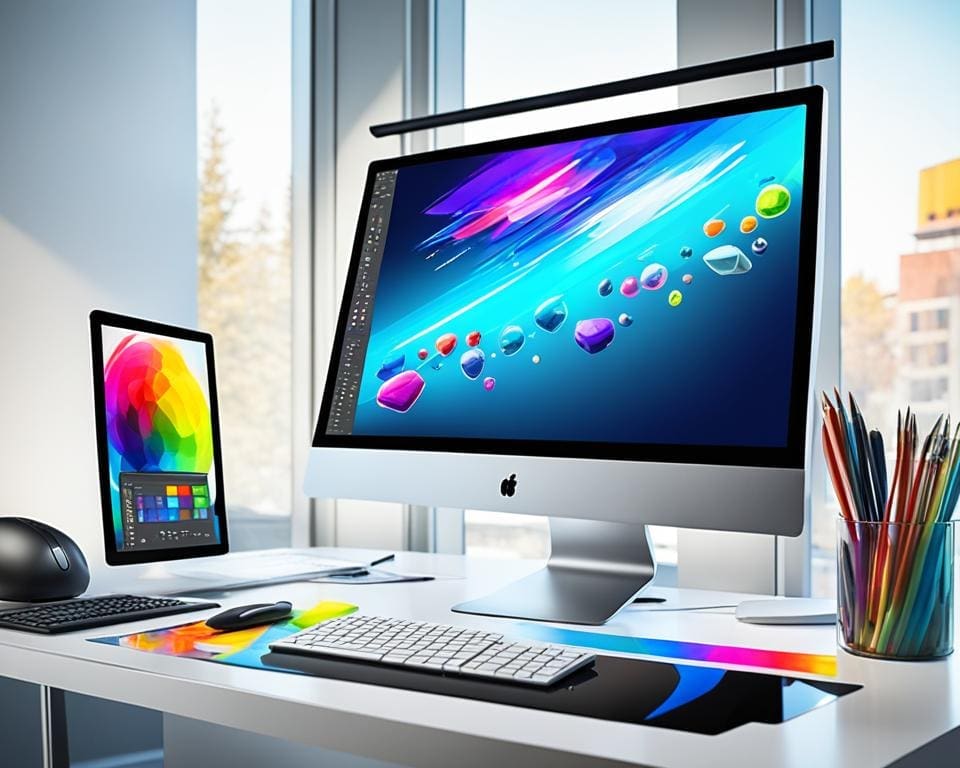In today’s quick-paced digital world, creative software is key for aspiring artists. It unlocks artistic potential and opens new paths for creativity. Artists of all levels have many choices, like Procreate and Procreate Pocket. Procreate is popular for its high-resolution canvases and wide range of brushes. It suits beginners and professionals alike.
Studies show 80% of successful digital artists knew their goals before choosing their tools. This shows making informed choices is crucial in your creative path. Digital art tools are more than apps; they’re gateways to express creativity and develop your unique style.
Artistic growth often involves exploring different software through hands-on experimentation. 62% of artists say this method helps them learn software functions best. With many possibilities available, aspiring artists can start their creative journeys with confidence and passion.
Essential Art Software for Digital Creatives
For digital artists starting out, choosing the right software is crucial. There are many popular tools available. Each one has special features and easy-to-use interfaces that unleash endless creative opportunities. Picking the best software can greatly boost artistic skills and make creating art easier, leading to outstanding work.
Overview of Popular Digital Art Tools
Many artists choose well-known software for their art. Adobe Photoshop is top choice for editing images and painting. It is used in many fields. Corel Painter is great for those who want their work to have a real painted look, thanks to its variety of brushes. Clip Studio Paint is favored by manga and comic creators for its flexible drawing tools.
Krita is good for beginners because it is easy to use. GIMP is a free option for those just starting with digital art. It’s great for anyone on a tight budget. These tools show that there is something for every artist, depending on what they like and need for their projects.
Graphic Design Software for Beginners
For newbies in graphic design, simple software can make a big difference. Canva makes designing easy with its drag-and-drop feature. It allows anyone to create good-looking designs without needing a lot of experience. Affinity Designer has more advanced tools for those wanting to learn more about graphic design.
Trying out these graphic design programs helps beginners gain important skills. It helps them start creating confidently. Working with these tools also encourages creativity and opens new opportunities in art.

Creative Software for Aspiring Artists
Finding the right art tools is key on an artist’s path. The market has so many options, choosing can feel hard. Knowing what each software offers is vital for a good choice.
How to Choose the Right Tools for Your Art Journey
Think about these things when picking digital art software:
- Personal Goals: Decide your art goals. Do you want to make illustrations, animations, or graphic designs?
- Ease of Use: Look for software that’s easy to use. It should let you be creative without difficult tools.
- Compatibility: Check if the software works with your computer. Some are only for Windows or macOS.
- Functionality: Think about what features you need. Consider things like layers, brush options, or animation tools.
Hands-on Experimentation with Free Trials
Trying free trials is a smart move in learning digital art. It lets you test different programmes without spending money. Adobe Photoshop and Clip Studio Paint offer trials. This way, you can find what software matches your style, boosting your confidence in art.
Learning and Mastering Digital Art Tools
Starting with digital art needs both dedication and curiosity. Joining artist communities helps you grow by sharing tips and experiences. Sites like Instagram, Twitter, and ArtStation are great for showing your work and talking with other artists. By getting involved in these places, you can find new ideas and improve your art.
Taking structured courses can also boost your skills. They provide in-depth knowledge on programs such as Adobe Photoshop or Krita. Plus, online tutorials are handy for refining techniques at your own pace. Making it a habit to go over what you’ve learned helps you become more creative and stay ahead in the digital world.
Trying out different tools and methods in your software is key. Experimenting with brushes and learning about colour theory are vital for making eye-catching art. So, keep exploring and practising. This will not only define your style but also make your digital art journey richer and help you achieve your artistic goals.









